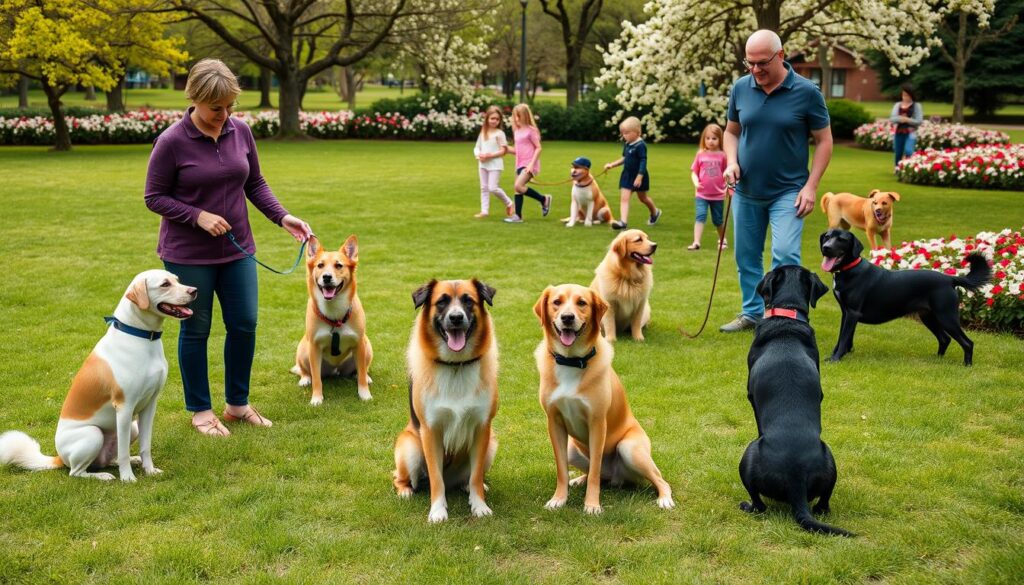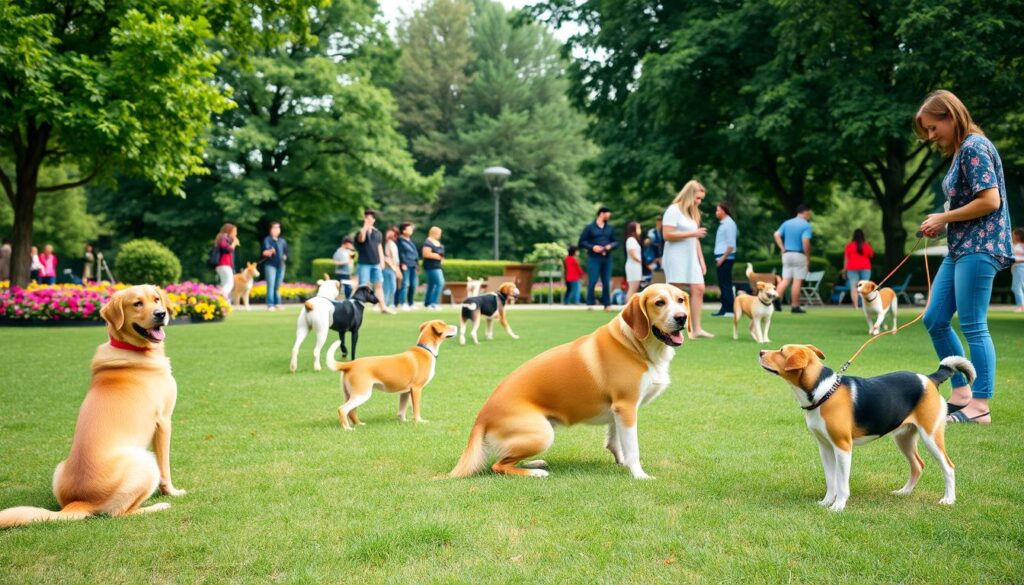That Ensure Good Behavior in Various Situations

Having a dog is a joy, but it also means teaching them to behave well. Learning basic dog commands is key to raising a well-behaved and happy dog. We’ll look at important commands like sit, stay, come, and heel. These commands help you and your dog have a better time together.
Key Takeaways
- Mastering basic dog commands is crucial for ensuring good behavior in various situations.
- The fundamental commands covered include sit, stay, come, down, heel, and more.
- Effective training strengthens the bond between you and your canine companion.
- Obedience training helps your dog become more responsive and well-behaved.
- Incorporating these commands into your dog’s routine can lead to a more enjoyable and stress-free relationship.
Introduction to Dog Training
Starting a dog training journey is very rewarding for both you and your dog. It’s great whether you’re new to pet ownership or have had dogs before. Learning the basics of dog training is key to a strong, positive bond with your pet.
>>> Click Here To Watch Our FREE Dog Training Workshop <<<
The Importance of Obedience Training
Obedience training is crucial for a well-behaved dog. It teaches your pet important commands and cues. This helps them learn good manners, be more responsive, and avoid bad behaviors.
Training also makes your dog-owner relationship stronger. It builds trust, improves communication, and deepens your bond.
Building a Strong Bond with Your Furry Friend
Dog training is also vital for your emotional connection with your dog. Using positive training methods helps your pet feel confident and improves their canine behavior modification. This makes your relationship more harmonious and fulfilling.
Starting dog training is an investment in your pet’s future and yours. It lays the groundwork for a lifetime of happiness, companionship, and understanding with your furry friend.

1. The “SIT” Command
The sit command is a basic dog command that’s essential. Learning it helps your dog understand who’s in charge. It also improves their behavior and manners.
Teaching your dog to sit on command is a great start. It’s the foundation for more complex commands. It shows your dog who’s boss and helps them behave better.
Teaching Your Dog to Sit on Cue
Positive reinforcement is the best way to teach your dog to sit. This method rewards good behavior and avoids punishment. It strengthens your bond and makes training easier.
Here’s how to teach your dog to sit:
- Find a quiet place with no distractions.
- Hold a treat near your dog’s nose and move it back. This makes them sit.
- When they sit, say “sit” and give them the treat and praise.
- Keep practicing until they sit right away when you say “sit”.
- Then, practice in different places and with distractions to make it stick.
Teaching your dog to sit takes patience and consistency. Positive reinforcement makes it easier and faster. It sets them up for success in their training.

The key to successful dog training is to make it a positive experience for your furry friend. By using reinforcement-based techniques, you can build a strong bond and help your dog learn essential commands with ease.
2. The “STAY” Command
The stay command is a key obedience skill. It teaches your dog to stay in one spot until you say it’s okay to move. This command is vital for your dog’s safety and good manners in many situations. It helps keep them from running into the street and keeps them calm at social events.
Learning the stay command takes patience and a step-by-step plan. Start by teaching your dog to stay in a sit or down position for a little while. Give them praise and treats when they do well. Then, slowly move further away from them while they stay, rewarding them each time.
- Start with short stays, like 5-10 seconds, and gradually increase the time.
- Use distractions, like toys or treats, to test their impulse control and reinforce the command.
- Practice the stay command in various places, from home to the park, to help them generalize the behavior.
Consistent training and positive feedback are essential for teaching your dog to stay reliably. This basic command improves their impulse control and strengthens your bond. With time and effort, your dog will become a well-behaved, responsive, and trustworthy friend. The stay command is a game-changer for dog owners. It’s not just about obedience; it’s about keeping your dog safe and setting them up for success in any situation.
3. The “COME” Command
The come command, or recall, is key for dog safety and obedience. It ensures your dog comes back to you, even when distracted. We’ll look at ways to teach your dog to come reliably.
Recall Training for Reliable Responses
Recall training is vital for obedience. A strong recall keeps your dog safe and strengthens your bond. Here are tips for a reliable come command:
- Start early: Begin recall training as soon as possible, using positive reinforcement and making it a fun, rewarding experience for your dog.
- Use a unique recall cue: Choose a specific word or phrase, such as “come” or “here,” and use it consistently every time you call your dog.
- Practice in low-distraction environments: Gradually increase the difficulty by training in more stimulating locations, ensuring your dog responds well despite potential distractions.
- Reward with praise and treats: Offer enthusiastic praise and high-value treats when your dog comes to you, reinforcing the behavior you want to see.
- Avoid punishing failed recalls: If your dog doesn’t come when called, avoid scolding or punishing them, as this can undermine their trust and make them less likely to respond in the future.
By consistently using these recall training techniques, you can teach your dog to come when called. This promotes safety and strengthens your bond. A reliable recall is one of the most important skills you can teach your dog. It can be the difference between your dog’s safety and a dangerous or even tragic situation.
4. The “DOWN” Command
The down command is a basic dog command that’s very useful. It helps your dog stay calm and obedient. This makes it a great tool for training.
Mastering the Down Position
Teaching your dog the down command means getting them to lie down. This command is great for calming your dog and teaching them to listen. The secret is to use positive training that rewards them for good behavior.
- Begin by using a treat to lure your dog into a lying position. Slowly move your hand to the ground while saying “down.”
- When your dog lies down, give them a treat and lots of praise right away.
- Slowly increase how long your dog stays in the down position. Reward them at different times to help them learn.
- Practice the down command in different places. This helps your dog learn to do it everywhere.
Learning the down position is a big step in dog training. It gives you a way to keep your dog calm and obedient in many situations.
Adding the down command to your dog’s training will make them more obedient, well-behaved, and responsive.
>>> Click Here To Watch Our FREE Dog Training Workshop <<<
5. The “HEEL” Command
Learning the heel command is key to teaching dogs to heel and improving their obedience. It helps your dog walk calmly by your side, making walks and outings easier. We’ll look at leash training tips and reinforcement-based training to help you have a well-behaved dog.
The heel command is great for keeping your dog close in busy places or at formal events. It strengthens your bond, improves their obedience commands, and keeps them safe in different canine behavior situations.
- Start with positive reinforcement: Reward your dog with treats and praise when they walk by your side. This starts the good behavior and lays the groundwork for more training.
- Incorporate the verbal cue: When your dog gets used to walking with you, add the “heel” command. Use it every time they’re in the right spot to reinforce the connection.
- Practice in different environments: Take your dog to new places with different sights and sounds while keeping the heel command. This makes the behavior more general and keeps your dog focused and obedient everywhere.
- Use positive reinforcement: Always give your dog treats, praise, or their favorite toy when they heel well. This positive approach encourages good behavior and strengthens your bond.
Mastering the heel command makes your dog more obedient and strengthens your bond. Remember, patience and consistency are crucial in teaching dogs to heel and reinforcing obedience. With the right method, your dog will be a happy, attentive companion for all your adventures. A well-trained dog is a joy to walk with, and the heel command is the foundation for that experience.”
Basic Dog Commands
Reinforcing Basic Obedience Commands
Learning basic dog commands is just the start. To keep your dog obedient and well-behaved, you need to keep practicing and using positive reinforcement. By making these commands a part of your daily life, you’ll strengthen your bond with your dog. This also helps them stay responsive in different situations.
Positive reinforcement is key when teaching your dog. Use treats, praise, or their favorite toys to reward them when they do something right. This method is better than punishment because it makes your dog want to do the command again.
Being consistent in your training is also very important. Always give clear instructions and use the same commands and expectations. If everyone in the family does this, your dog will learn and remember better. Mixed signals can confuse your dog and make training harder.
Make sure to practice regularly. Short training sessions during meals or playtime can keep your dog’s skills sharp. This regular practice helps your dog stay obedient in many situations.
By using these techniques, you can build a strong foundation of obedience in your dog. A little effort and patience can make a big difference in your dog’s behavior. It also strengthens your bond with them. Consistency is the key to successful dog training. Repeating the same commands and expectations across all family members will help your dog understand and retain the lessons.
6. The “LEAVE IT” Command
Teaching your dog the “leave it” command is key in training. It helps them learn self-control and manage impulses. This command improves their behavior and strengthens your bond.
Teaching Your Dog Self-Control
Learning the “leave it” command requires a step-by-step approach. It’s all about canine behavior modification and reinforcement-based training. By teaching your dog to ignore tempting things, you help them develop impulse control.
To start, use a quiet place and a treat your dog loves, like cooked chicken or cheese. Hold the treat in your hand and say “leave it” when they try to get it. If they back away, give them praise and a treat from your other hand.
- Make it harder by placing the treat on the ground and covering it with your foot. Slowly, remove your foot so the treat is just on the floor.
- Practice in busier places to make sure they remember the command.
- Be patient and keep training up, as it takes time for them to learn.
Adding the “leave it” command to your dog’s training helps with self-control. It also improves their canine behavior modification and how well they listen to you. The ‘leave it’ command is a game-changer in reinforcement-based training, empowering you to keep your dog safe and well-behaved in a variety of situations.”
7. The “DROP IT” Command
The “drop it” command is crucial for dog owners to learn. It stops dogs from picking up harmful items or holding onto things they shouldn’t. Teaching your dog to drop things on command builds trust and safety.
Teaching dogs to drop it works best with positive methods and knowing how dogs behave. You want your dog to think “drop it” means good things, not bad. This makes them more likely to listen and learn.
Mastering the Drop It Command
To teach the “drop it” command, follow these steps:
- Choose something your dog likes, like a toy or treat.
- Hold the object and say “drop it” in a calm, firm voice.
- Give your dog praise, pets, or a treat when they drop it.
- Make the task harder by asking your dog to hold it longer before rewarding them.
- Practice in different places and situations, like during play or when they see something they shouldn’t.
Being consistent and patient is important. With time and positive rewards, your dog will learn to drop things when asked. This improves their behavior and keeps them safe. The ‘drop it’ command is one of the most important skills you can teach your dog. It builds trust, safety, and a strong bond between you and your furry friend.
Learning the “drop it” command gives you confidence in handling different situations. You’ll use positive methods and training to keep your dog safe and well-behaved.
8. The “WATCH ME” Command
Learning the watch me command is key for obedience commands and canine behavior modification. It keeps your dog’s focus on you. This strengthens your bond and ensures good behavior in many situations.
Teaching dogs to watch me is a basic focus training method. It should start early in your dog’s reinforcement-based training. By rewarding them for eye contact, you build a habit of attention. This habit will help your dog throughout their life.
Building a Reliable Watch Me Cue
To teach the watch me command, start by catching your dog’s gaze and rewarding them right away. Use treats or praise. Then, increase how long they need to keep their eyes on you before getting a reward. Practice in different places and with distractions to make the command stronger.
- Start in a quiet, distraction-free area and reward your dog for looking directly at you.
- Slowly increase the time your dog must maintain eye contact before receiving the reward.
- Practice the watch me command in different locations and with various environmental stimuli to generalize the behavior.
Being consistent and patient is crucial when teaching dogs to watch me. Regular practice helps your dog focus and pay attention. This is essential for success in obedience and more.
Conclusion
In this article, we’ve looked at the key dog l for good behavior. We’ve covered “sit”, “stay”, “come”, “down”, “heel”, “leave it”, “drop it” and “watch me”. These are crucial for a strong bond with your dog.
Remember, learning these commands is just the start. Keep practicing, be patient, and commit to your dog’s education. This will help you both enjoy a lifelong friendship. Also, using dog training classes or expert advice can be very helpful.
By following these tips and using available resources, you’ll have a great relationship with your dog. Let your dog’s full potential shine and start a journey of understanding and respect together.
FAQ
What are the basic dog commands every pet owner should teach their furry friend?
Essential dog commands include sit, stay, come, down, heel, leave it, drop it and watch me. Learning these commands helps your dog behave well and strengthens your bond.
Why is obedience training important for dogs?
Obedience training teaches dogs good manners and improves their response. It also builds a strong, positive relationship between you and your dog.
How do I teach my dog the “sit” command?
To teach “sit,” hold a treat near your dog’s nose and move it back towards their shoulders. This will make them sit. Reward them with the treat and praise. Increase the sit time in each session.
What is the purpose of the “stay” command?
The “stay” command teaches your dog to stay in one place until released. It helps with impulse control and is useful in many situations.
How can I train my dog to reliably come when called?
To train recall, start by calling your dog from a short distance and reward them. Gradually increase the distance and duration. Avoid punishing them for not responding.
How do I teach my dog the “down” command?
To teach “down,” lure your dog into the down position with a treat. Reward them and practice the cue. Increase the down time in different places.
What is the purpose of the “heel” command?
The “heel” command teaches your dog to walk by your side calmly. It’s important for safety and manners. Reward them for staying by your side and increase distractions.
How can I reinforce my dog’s basic obedience commands?
Practice consistently, use positive reinforcement, and reward often. Include commands in your daily routine and increase difficulty and duration.
How do I teach my dog the “leave it” command?
The “leave it” command teaches your dog to ignore tempting objects. Start by placing a treat on the floor and use the cue to prevent them from taking it. Reward them for ignoring the treat and increase difficulty.
What is the purpose of the “drop it” command?
The “drop it” command teaches your dog to release objects on cue. It prevents them from picking up dangerous items. Trade the object for a reward and gradually teach them to drop it on command.
How can I teach my dog the “watch me” command?
The “watch me” command helps keep your dog focused. Reward them for eye contact and introduce the verbal cue. Practice and positive reinforcement are key.
